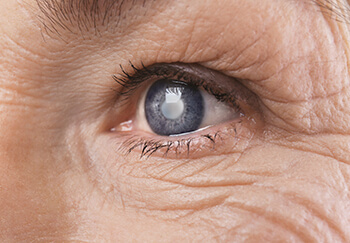What is a cataract?
 A cataract is a cloudy area in the lens of the eye. The lens helps focus light on the retina at the back of the eye. It is located inside the eye behind the iris (the colored part of the eye). As a cataract grows larger over time, the cloudiness worsens and causes vision problems.
A cataract is a cloudy area in the lens of the eye. The lens helps focus light on the retina at the back of the eye. It is located inside the eye behind the iris (the colored part of the eye). As a cataract grows larger over time, the cloudiness worsens and causes vision problems.
How does it occur?
Most cataracts occur naturally as people get older. What causes cataracts is not known, but many factors may also contribute to their formation, such as: eye injury, diabetes or other diseases, exposure to radiation, especially x-rays, long-term use of steroid medication, exposure to toxic substances, inflammatory disorder of the eye (iritis), and prolonged exposure to sunlight. A child may be born with cataracts or develop them at an early age. These cataracts, called congenital cataracts, may be caused by a genetic disorder (such as Down syndrome) or by a condition the mother had during pregnancy (such as measles). They also may be inherited. Cataracts do not spread from one eye to the other, but many people have cataracts in both eyes.
What are the symptoms?
The symptoms of a cataract include:
- Blurred vision
- A need for frequent changes in your eyeglasses or contacts
- Trouble driving at night
- Sensitivity to bright light
- Change in color vision (yellow, orange, and red appear brighter and blue appears dull).
Cataracts do not cause complete blindness. However, it is possible to lose enough vision to be declared legally blind.
How is it diagnosed?
The symptoms of a cataract develop slowly and are painless. The condition may go unnoticed and undiagnosed for a long time. It is often first diagnosed during a routine eye exam. Dr. Jovkar will thoroughly examine your eyes and evaluate your symptoms to determine the best course of treatment.
How is it treated?
If a cataract is not interfering with your lifestyle or work, Dr. Jovkar may suggest changing your glasses or using brighter lights to help you read. If the cataract is seriously affecting your vision and cannot be helped with glasses or contact lenses, Dr. Jovkar may need to remove the cataract. This type of surgery is called cataract extraction surgery. Dr. Jovkar may first use sound waves (ultrasound) to break up the lens so the pieces can then be removed. This part of the procedure is called phacoemulsification. After the lens is removed, Dr. Jovkar may put a new lens in your eye (intraocular lens implantation). Lasers are not used to remove cataracts. However, lasers may be used to clear a cloudy membrane that may develop after cataract surgery.
How long will the effects last?
Decreased vision from cataracts is reversible with cataract surgery. Surgery to remove cataracts is very successful in improving visual acuity.
How can I take care of myself?
Be sure to follow Dr. Jovkar’s instructions. Make an appointment to see Dr. Jovkar if your vision gets worse. Be careful when driving at night; a cataract can make lights such as oncoming headlights seem very bright, causing a glare that makes it difficult to see.
What can be done to help prevent cataracts?
You may reduce the risk of damaging your eyes and in turn reduce the risk of developing cataracts by wearing goggles or safety glasses at work or during recreation where your eyes could be injured. Wearing glasses with a UV coating that protects your eyes from sunlight might delay some types of cataracts.
